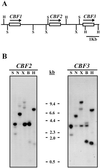The Arabidopsis CBF gene family is composed of three genes encoding AP2 domain-containing proteins whose expression Is regulated by low temperature but not by abscisic acid or dehydration
- PMID: 9952441
- PMCID: PMC32122
- DOI: 10.1104/pp.119.2.463
The Arabidopsis CBF gene family is composed of three genes encoding AP2 domain-containing proteins whose expression Is regulated by low temperature but not by abscisic acid or dehydration
Abstract
We have identified two genes from Arabidopsis that show high similarity with CBF1, a gene encoding an AP2 domain-containing transcriptional activator that binds to the low-temperature-responsive element CCGAC and induces the expression of some cold-regulated genes, increasing plant freezing tolerance. These two genes, which we have named CBF2 and CBF3, also encode proteins containing AP2 DNA-binding motifs. Furthermore, like CBF1, CBF2 and CBF3 proteins also include putative nuclear-localization signals and potential acidic activation domains. The CBF2 and CBF3 genes are linked to CBF1, constituting a cluster on the bottom arm of chromosome IV. The high level of similarity among the three CBF genes, their tandem organization, and the fact that they have the same transcriptional orientation all suggest a common origin. CBF1, CBF2, and CBF3 show identical expression patterns, being induced very rapidly by low-temperature treatment. However, in contrast to most of the cold-induced plant genes characterized, they are not responsive to abscisic acid or dehydration. Taken together, all of these data suggest that CBF2 and CBF3 may function as transcriptional activators, controlling the level of low-temperature gene expression and promoting freezing tolerance through an abscisic acid-independent pathway.
Figures





References
-
- Anderson B, Povinelli CM, Wentland MA, Shen Y, Muzny DM, Gibbs RA. Adaptor-based uracil glycosylase cloning simplifies shotgun library construction for large-scale sequencing. Anal Biochem. 1994;218:300–308. - PubMed
-
- Baker SS, Wilhelm KS, Thomashow MF. The 5′-region of Arabidopsis thaliana cor15a has cis-acting elements that confer cold-, drought- and ABA-regulated gene expression. Plant Mol Biol. 1994;24:701–713. - PubMed
Publication types
MeSH terms
Substances
LinkOut - more resources
Molecular Biology Databases
